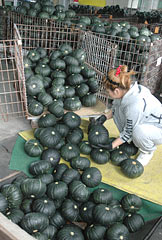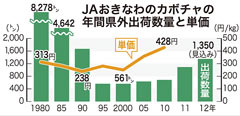Pumpkin production revives

On February 15, 2012, at the JA Okinawa Haebaru Branch, staff prepare to ship out pumpkins grown in Haebaru.
February 7, 2013 Maki Nagamine of Ryukyu Shimpo
Domestic production of pumpkins has started to revive in Okinawa. Since the 1980s, shipping volume of pumpkins from Okinawa decreased after low price pumpkins were imported in increasing quantities, but according to statistics released by JA Okinawa, in 2009 the shipping volume from Okinawa exceeded 1000 tons for the first time in about 20 years. It is estimated to have been 1350 tons in 2012, an increase of 23.7 percent compared with the previous year. There has been a growing production of pumpkins in various parts of Okinawa as the demand for safe food that people can be sure about has been increasing, and as the unit price rises.
Pumpkin has been one of Okinawa’s main agricultural items since the reversion. In 1980, JA shipped out 8278 tons of pumpkins to the main islands of Japan. With the liberalization of farm imports, the annual shipping volume decreased to 4642 tons in 1985, 1670 tons in 1990, 562 tons in 1995, and from that point on stayed at around 500 to 700 tons.
High demand for domestic produce due to growing concerns about safety of vegetables imported from China since the 2000s has stimulated local production of pumpkins. The unit price of locally produced pumpkins that used to range from 250 to 300 yen per one kilogram, increased to 358 yen in 2005 and 428 yen in 2010.
Hokkaido accounts for the majority of domestic production during the summer season, but during the period from winter to spring, especially from February to April, almost all domestically grown pumpkins are produced in Okinawa. Depending on the seasons, it fetches a price as high as 500 to 600 yen.
According to prefectural government statistics, in 2010 the crop in Okinawa was 3861 tons, which was 2.2 times more than that of 2001, and the harvest area had also expanded to 334 hectares, which was 2.1 times more. In Okinawa Prefecture, Haebaru, Miyako-jima, and Nago are the approved main production areas. The prefectural government supports these locations by setting up exhibitions, but other areas, such as Iriomote Island and Daito Island, are also increasing pumpkin production because the JA has started to promote production. The municipalities on other neighboring islands are also reported to be showing interest in training people to engage in pumpkin farming.
A JA staff member said, “The neighboring islands have larger areas of farm land and so are suitable for pumpkin production. Pumpkins keep well, so they can be shipped to other prefectures using low-cost shipping methods. I would like to encourage farmers in neighboring islands to grow pumpkins, and increase the annual shipment volume to 2000 tons in the course of the next three or four years.”
(English translation by T&CT, Megumi Chibana and Mark Ealey)
Previous Article:Brown sugar from Okinawa popular in Shanghai
Next Article:Spoonbill recovers to return to the wild
[Similar Articles]
- Shipping volume of kariyushi shirts exceeds 400,000
- Aquaculture production of estuary cod worth 120 million yen
- JA Okinawa begins shipping citrus tankan Hayata to locations throughout the country
- Okinawan sea grapes become a brand product
- Production of peucedanum japonicum up eight-fold in the last five years

 Webcam(Kokusai Street)
Webcam(Kokusai Street)


